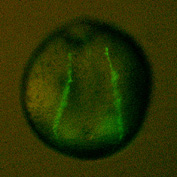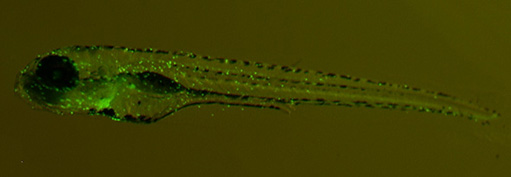

Analysis of Transcriptional Regulation Using Zebrafish
A number of laboratories are working to develop zebrafish as a vertebrate system for genetic analysis. This organism is particularly attractive for this purpose, because females can produce a large number of eggs, embryonic development is rapid, each generation can be produced within 60-70 days, embryos are transparent throughout the early developmental processes, and large numbers of fish can be raised in a relatively small space. These attributes suggest the possibility of conducting genetic screening using mutagenized populations of zebrafish to identify novel genes in vertebrates, a task difficult to accomplish in mammals. We can easily observe the whole mount effect of the target or reporter gene, because it is easy to over-express or inactivate target gene expression by microinjecting DNA or RNA into oocytes. We can challenge the inherent difficulties of unravelling transcriptional mechanisms using the advantageous zebrafish system.
・Role of the GATA-1 Transcription Factor in Hematopoiesis
Conservation in hematopoiesis between zebrafish and mammals has already been shown. Zebrafish GATA-1, as well as mammalian GATA-1, is expressed specifically in erythroid progenitor cells. We are trying to elucidate the role of transcription factors using the advantages of the zebrafish model. We produced a transgenic line showing green fluorescence in erythroblasts by microinjecting the GATA-1 control region ligated to GFP (Fig. 1).


Fig. 1 gata1-GFP fish
Over-expression of GATA-1 induced ectopic GFP expression in this transgenic fish, suggesting the GATA-1 gene itself to be regulated by a positive feedback mechanism in vivo. (Refs.→ Transcriptional Regulation of Erythroid and Megakaryocytic Differentiation、Regulatory Mechanism of GATA-1 Gene Expression )
・Mechanism of Transcription Factor Six in Sensory Organ Development
Similar mechanisms direct the early development of sensory organs such as the optic, olfactory and otic placodes, because these organs share common features. The Six gene family is specifically expressed during the development of these organs, suggesting that transcription factor Six is important for sensory organ development. Members of the Six family are homeobox-containing genes representing the vertebrate homologues of the transcription factor sine oculis, which is important for eye development in Drosophila. Half a dozen members of the Six family have been reported in mouse. The Six3 gene is expressed in the otic placode of zebrafish, while the Six4 gene is expressed in the olfactory and otic placodes of both zebrafish and mouse. These data suggest a conserved role of Six3 or Six4 between zebrafish and mammals. We are striving to decipher the function of transcription factor Six by over-expression analysis using zebrafish embryos. We recently elucidated that Six3 is involved in eye and forebrain development and interacts with the co-repressor Groucho (Fig. 2).



Fig. 2. The size of the eye and forebrain is enlarged by an overexpression of the wild-type or repressor-type of Six3 (left) but reduced by the activator-type (center). Right, control embryo.
On the other hand, Six4 has been suggested to function as an activator. Thus, we are focusing on the difference in function or on some downstream gene.
・Transcriptional Regulation of Xenobiotic Detoxification Genes
The conservation in genes between mammals and fish, as revealed by genome information, suggests that zebrafish have a similar system of xenobiotic detoxification. Still, it is possible that there are induction mechanisms unique to zebrafish owing to their aqueous environment. We wish to know if transcriptional induction mechanisms such as the Nrf2-Keap1 system or the AhR-Arnt system exist in fish. To answer this question, we are isolating and analyzing the zebrafish Nrf2, Keap1, AhR and Arnt genes. (Refs.→ Involvement of Nrf2 and Keap1 in the Induction of Defense Enzymes/Proteins in Response to a Hazardous Environment 、AhR and Nrf2 as Key Molecules in Xenobiotic Detoxification)


Fig. 3. Genes encoding phase II detoxification enzymes (gstp) are induced by a treatment of electrophilic agents in zebrafish larvae (right). left, control larvae.
REFERENCE